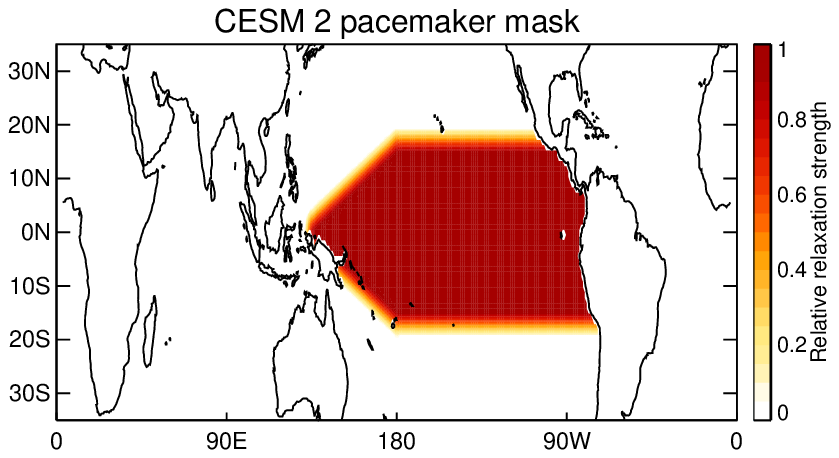Climate Variability & Change
Working Group CVCWG
CESM2 Pacific Pacemaker Ensemble
doi: 10.26024/gtrs-tf57
A 10-member ensemble of CESM2 (1 degree spatial resolution) simulations in which time-evolving SST anomalies in the eastern tropical Pacific are nudged to observations (NOAA Extended Reconstruction Sea Surface Temperature version 5: ERSSTv5) during 1880-2019. In this way, the observed evolution of ENSO is maintained in each simulation (i.e., ENSO is the pacemaker), with the rest of the model’s coupled climate system free to evolve. Note that only the SST anomalies, not the total SST, are nudged to observations, maintaining the model’s mean state, including any model biases. The nudging mask for the CESM2 pacemakers is shown in Fig 1. In the East Pacific, the nudging is full strength between 15S-15N and from the dateline to the American coast with a 5 degree latitude buffer region to the south and north where the strength of the relaxation is linearly reduced. West of the dateline, the nudging mask takes the form of a wedge shape, tapering off in latitude toward the Maritime continent. Full instructions for setting up pacemaker simulations along with details of how the nudging mask shown in Figure 1 was created can be found on the Instructions for reproducing website

Figure 1: The pacemaker relaxation mask. Shading shows the relative strength of the nudging with full strength = 1 in the eastern tropical Pacific and tapering off in latitude toward the Maritime continent. Full details on how this mask was created can be found here.
We kindly ask that you acknowledge the CVCWG when presenting results based on the CESM2 Pacemaker Ensemble in either oral and written form.
Project Details
- Simulation Names:
- b.e21.BHISTcmip6.f09_g17.pacemaker_pacific.0XX / b.e21.BSSP370cmip6.f09_g17.pacemaker_pacific.0XX, XX = 01-10
- b.e21.BHISTcmip6.f09_g17.pacemaker_pacific.0XX / b.e21.BSSP370cmip6.f09_g17.pacemaker_pacific.0XX, XX = 01-10
- Model Version: CESM2.1.2 Codebase | Documentation
- Resolution: 0.9x1.25_gx1v6 (CESM nominal 1o grid)
- Years: 1880-2019
- Ensemble Size: 10 members
- Time Frequencies Saved: Monthly, Daily, 3-hourly
- Machine: NCAR:Cheyenne
- Compsets: BHISTcmip6 / BSSP370
Additional Notes: SST anomalies (relative to the 1880-2019 climatology) are relaxed toward ERSSTv5 observations over the region shown in Figure 1. All CMIP6 time-varying external, natural and anthropogenic forcings were specified in this ensemble, using historical forcings prior to 2014, and SSP3-7.0 forcing thereafter.
Data Acquisition
This data is available on both the NCAR Climate Data Gateway (web-access) and NCAR's casper system (NCAR-internal).
- NCAR-internal
Location on NCAR's campaign store or on the NCAR machine casper:- /glade/campaign/cesm/development/cvcwg/cvwg/b.e21.BHISTSSP370cmip6.f09_g17.pacemaker_pacific/
- web-access
The following are step by step directions on how to download this data from the Climate Data Gateway.- Proceed to the CESM2 Pacific Pacemaker Ensemble page.
- Scroll to the bottom of that page under Child Datasets, and click on the component and time frequency you are interested in.
- The files are organized by variable, listed at the end of each link. Click on the variable you are interested in.
- Click on the Download Options button. At this point, if you have not logged into the Climate Data Gateway you can do so now. If you have not registered before, registration is free and quick.
- Upon logging in you will see a file listing. Once you have identified a file that you would like to download, click on the check box to the left of the file name. Note that you can select multiple files on this page at once. (However, one cannot select/download multiple files across variables at once.) When you are finished selecting files, scroll to the top (or bottom) of the page and click on the Download Options for Selection box.
- Click the Request File Transfer from Archive, and choose whether to use a Curl or Wget script to download your selected data.